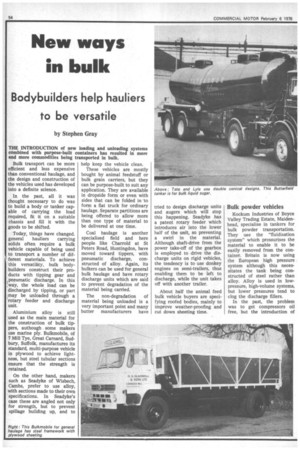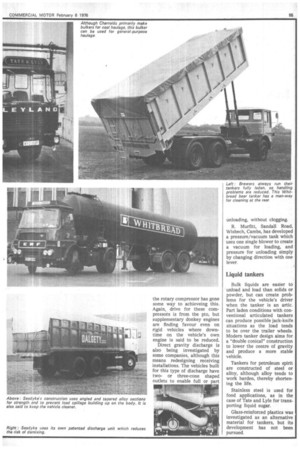New ways in bulk
Page 56

Page 57

If you've noticed an error in this article please click here to report it so we can fix it.
Bodybuilders help hauliers to be versatile
by Stephen Gray
THE INTRODUCTION of new loading and unloading systems combined with purpose-built containers has resulted in more and more commodities being transported in bulk.
Bulk transport can be more efficient and less expensive than conventional haulage, and the design and construction of the vehicles used has developed into a definite science.
In the past, all it was thought necessary to do was to build a body or tanker capable of carrying the load required, fit it on a suitable chassis and fill it with the goods to be shifted.
Today, things have changed. general hauliers carrying solids often require a bulk vehicle capable of being used to transport a number of different materials. To achieve this versatility, bulk bodybuilders construct their products with tipping gear and pneumatic discharge. In this :way, the whole load can be discharged by tipping, or part may be unloaded through a rotary feeder and discharge unit.
Aluminium alloy is still used as the main material for the construction of bulk tippers, authough some makers use marine ply. Bulkrnobile, of 7 Mill Tye, Great Carnard, Sudbury, Suffolk, manufactures its standard, multi-purpose vehicle in plywood to achieve lightness, but steel tubular sections ensure that the strength is retained.
On the other hand, makers such as Seadyke of Wisbech, Cambs, prefer to use alloy, with sections made to their own specifications. In Seadyke's case these are angled not only for strength, but to prevent spillage building up, and to help keep the vehicle clean.
These vehicles are mostly bought by animal feedstuff or bulk grain carriers, but they can be purpose-built to suit any application. They are available in dropside form or even with sides that can be folded in 'to form a flat truck for ordinary haulage. Separate partitions are being offered to allow more than one type of material to be delivered at one time.
Coal haulage is another specialised field and here people like Charrold at St Peters Road, Huntingdon, have moved toward tippers, with pneumatic discharge, constructed of alloy. Again, its buikers can be used for general bulk haulage and have rotary discharge units which are said to prevent degradation of the material being carried.
The non-degradation of material being unloaded is a very important point and many butter manufacturers have tried to design discharge units and augers which will stop this happening. Seadyke has a patent rotary feeder which introduces air into the lower half of the unit, so preventing a swirl in the material. Although shaft-drive from the power take-off of the gearbox is employed to drive the discharge units on rigid vehicles, the tendency is to use donkey engines on semi-trailers, thus enabling them to be left to discharge, while the unit takes off with another trailer.
About half the animal feed bulk vehicle buyers are specifying roofed bodies, mainly to improve weather-proofing and cut down sheeting time.
Bulk powder vehicles
Kockum Industries of Boyce Valley Trading Estate, Maidenhead, specialise in tankers for bulk powder transportation. They use the "fluidisation system" which pressurises the material to enable it to be easily removed from the container. Britain is now using the European high pressure system although this necessitates the tank being constructed of steel rather than alloy. Alloy is used in lowpressure, high-volume systems, but lower pressures tend to clog the discharge fillers.
In the past, the problem was to get compressors oil free, but the introduction of the rotary compressor has gone some way to achieveing this. Again, drive for these compressors is from the pto, but supplementary donkey engines are finding favour even on rigid vehicles where downtime on the vehicle's own engine is said to be reduced.
Direct gravity discharge is also being investigated by some companies, although this means redesigning receiving installations. The vehicles built for this type of discharge have twoor three-cone shaped outlets to enable full or part unloading, without clogging.
R. Murfitt, Sandal]. Road, Wisbech, Cambs, has developed a pressure/vacuum tank which uses one single blower to create a vacuum for loading, and pressure for unloading simply by changing direction with one lever.
Liquid tankers
Bulk liquids are easier to unload and load than solids or powder, but can create problems for the vehicle's driver when the tanker is an artic. Part laden conditions with conventional articulated tankers can produce possible jack-knife situations as the load tends to be over the trailer wheels. Modern tanker design aims for a "double conical" construction to lower the centre of gravity and produce a more stable vehicle.
Tankers for petroleum spirit are constructed of steel or alloy, although alloy tends to work harden, thereby shortening the life.
Stainless steel is used for food applications, as in the case of Tate and Lyle for transporting liquid sugar.
Glass-reinforced plastics was investigated as an alternative material for tankers, but its development has not been pursued.
































































































































